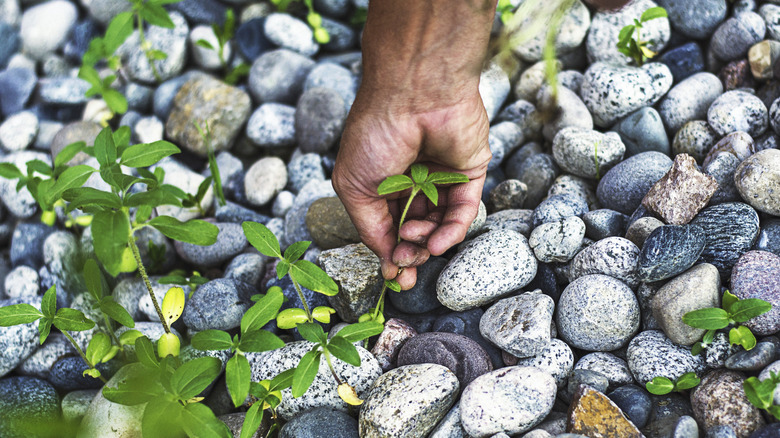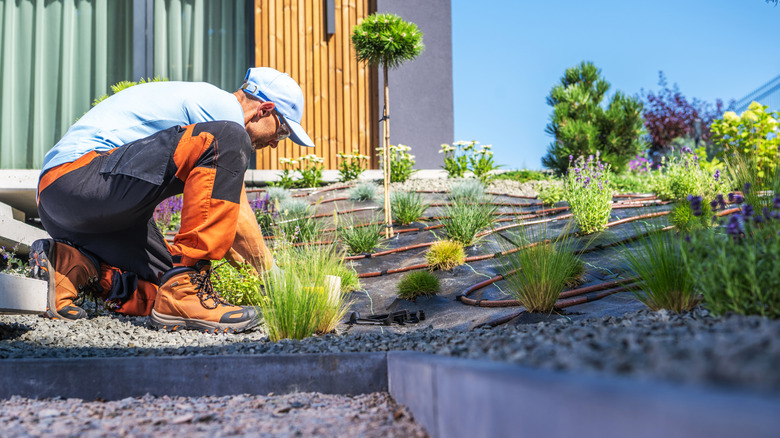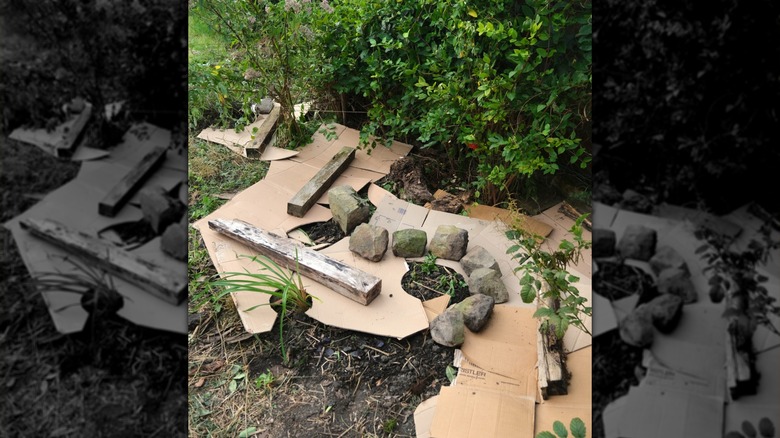You Shouldn't Be Laying Wet Cardboard Under Your Gravel. Here's Why
If you're an avid gardener, you have likely heard every trick in the book to control weeds, and you've also probably learned that there is no silver bullet to keeping your garden bed perfectly weed-free. Not even a garden weeding robot has mastered the job perfectly ... not yet, anyway. Every method has its pros and cons, and the key is deciding on the one that best suits your garden's needs, and then managing your expectations. Many DIY landscapers don't realize that while gravel is an affordable and functional landscaping material, it requires routine care and maintenance to stay looking its best. Dealing with weeds tops the list of gravel woes.
One popular method for weed control is using a simple cardboard box hack. "If you are going for an organic garden, cardboard can be a great tool to suppress weeds or lawn or other vegetation initially," Sara Bendrick, Landscape contractor, media personality, and STIHL Spokesperson, exclusively tells House Digest. Bendrick owns Sarita Landscapes, and when she's not on a job site or consulting on landscape design, she shares her expertise across her social media channels to make landscaping tricks of the trade accessible to the masses. While she recommends using cardboard to kill weeds in some cases, underlaying gravel with cardboard is not a method she recommends. "It's not worth it," she says, "It breaks down and does not supply the long-term support that gravel needs." Instead, Bendrick shares her strategies for keeping weeds at bay under gravel and when (and where) cardboard can be beneficial in your garden.
Why gravel and cardboard don't mix and what to use instead
As sturdy as cardboard is, you might think it would make a solid underlayment for gravel. However, since cardboard decomposes, it will soon leave gravel exposed, where it "can get pressed into [the soil] and lost over time," Bendrick explains, speaking exclusively with House Digest. Gravel needs to be permanently separated from soil, so it requires a long-lasting layer of support rather than a biodegradable material like cardboard.
Instead of using cardboard to control weeds under gravel, Benrick recommends landscape fabric. "It will still need maintenance over time, but will greatly help with keeping the gravel separated from the soil and help with weeds," she says, adding that the exception to this rule is pea gravel, decomposed granite (DG), or anything with a thick, compacted base. "The fabric can get in the way of compaction of the material," she explains. In these cases, try these natural ingredients that will get rid of weeds in gravel. Still, if you're looking for a cheap, chemical-free, biodegradable way to control weeds, cardboard is the way to go in many cases, aside from gravel support. The key is knowing how to use it effectively.
The right conditions for using cardboard in your garden
Speaking exclusively with House Digest, Bendrick says cardboard "can be a good alternative for the landscape when working with garden areas with mulch." Used as sheet mulching, for example, cardboard can be layered with other materials to create a fresh start in your garden bed. "[Cardboard] blocks the initial weeds but then breaks down," Bendrick explains. The weeds should die off before the cardboard decomposes. Plus, cardboard is an earthworm's favorite meal, so it will draw worms up to further nourish the soil. Cardboard's ability to break down is also a key factor to a healthy garden. Not only does it provide organic matter to the soil, but it also allows new growth to anchor in the soil below. This makes it even more beneficial than landscape fabric when new growth is the goal, as the latter blocks young root systems from reaching the soil beneath it. When you lay the cardboard, wetting it first helps jump-start the decomposition process.
Bendrick's top tip to make the most of cardboard in the garden? Sufficient mulch. "You need a 4-to-6 inch layer of mulch," she explains. This should keep the cardboard from shifting. Not only that, but she says that since the cardboard breaks down, "[it] might provide no protection after a short while ... so sufficient mulch would need to cover the area."


